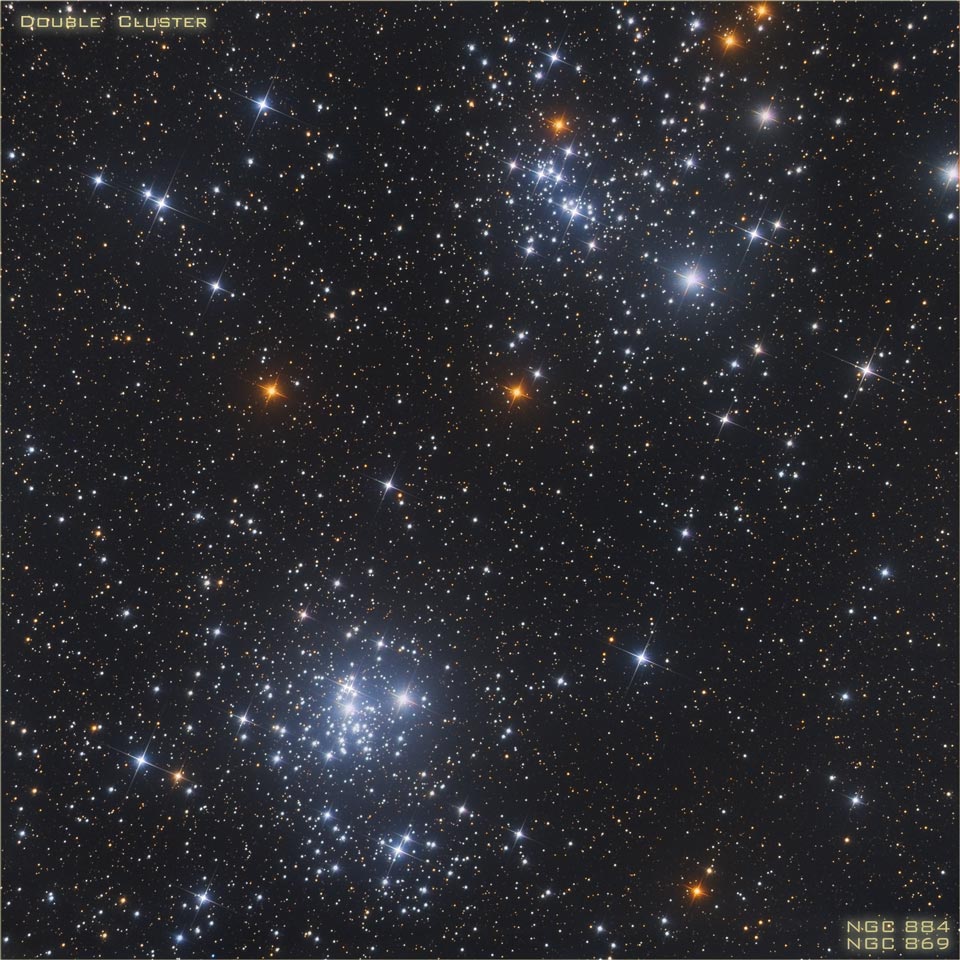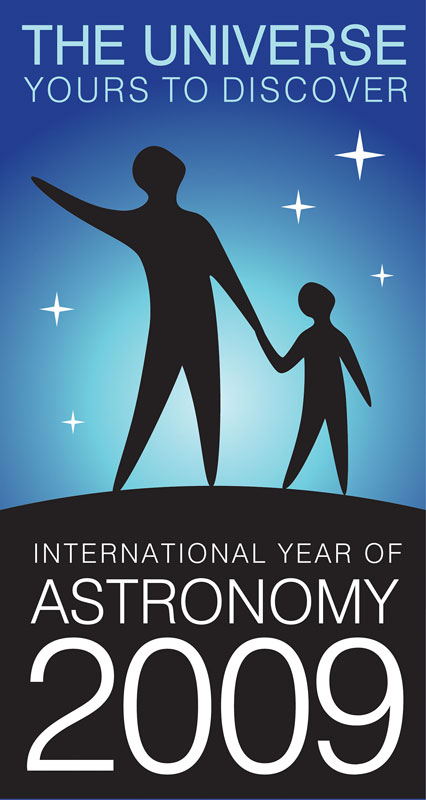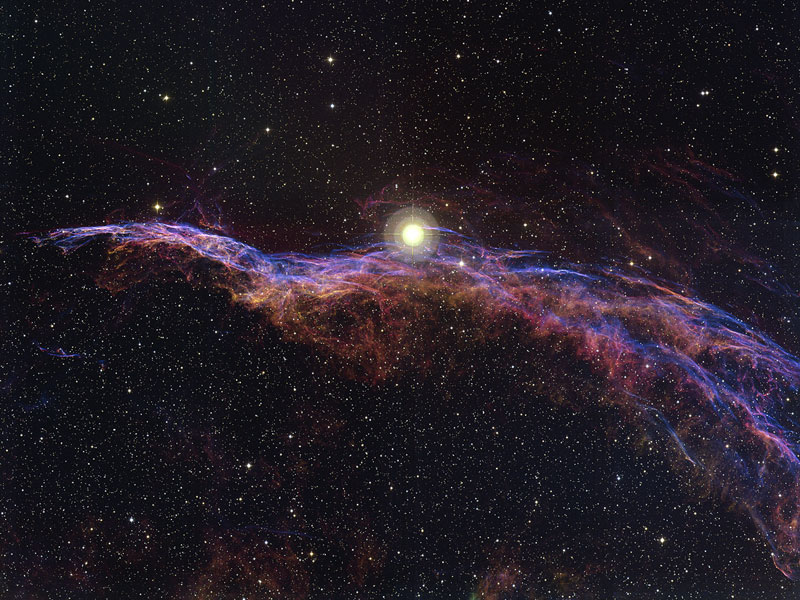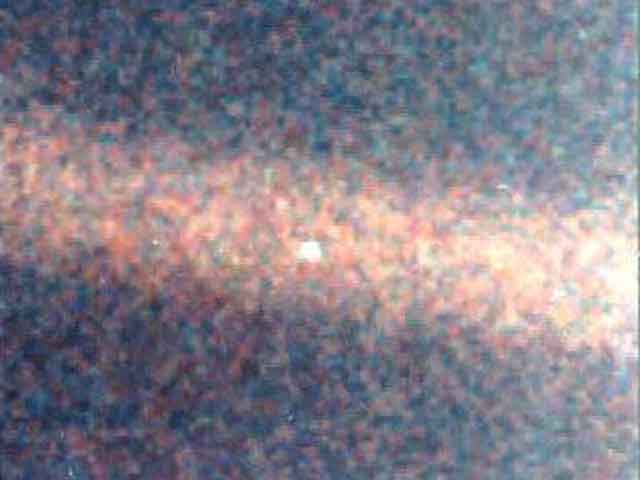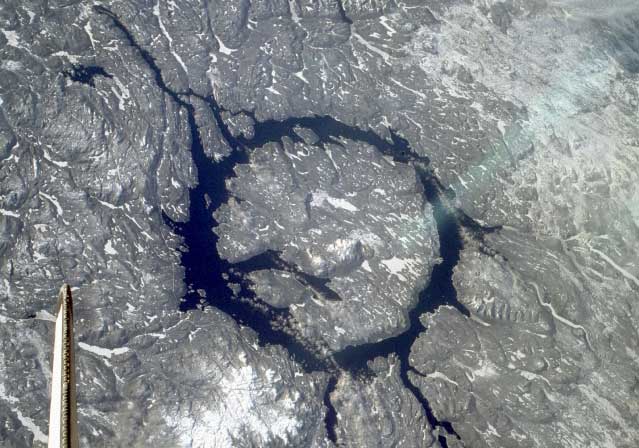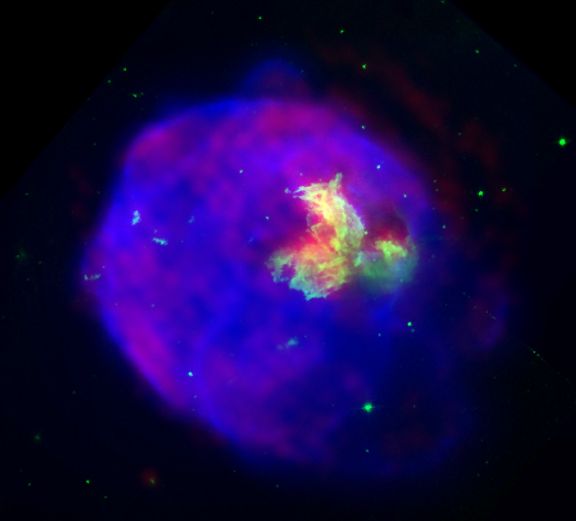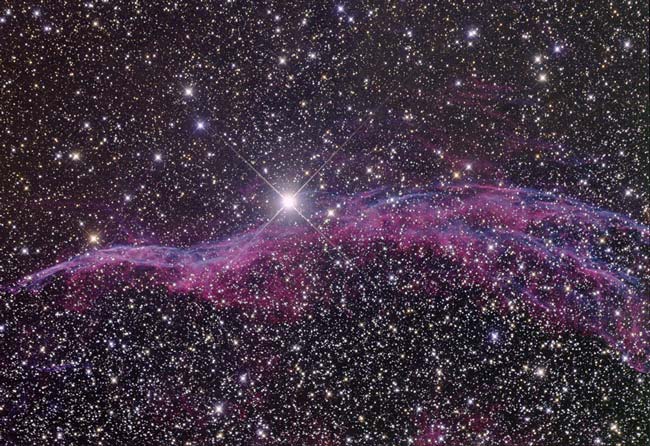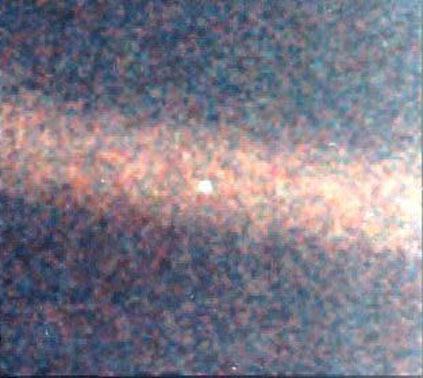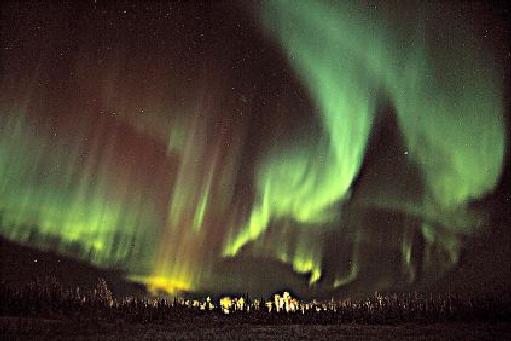Happy New Year!
| << Previous | Index | Next >> |
2015 The plane of our Milky Way Galaxy runs through this complex and beautiful skyscape. At the northwestern edge of the constellation Vela (the Sails) the telescopic frame is over 10 degrees wide, centered on the brightest glowing filaments of the Vela Supernova Remnant, an expanding debris cloud from the death explosion of a massive star. Light from the supernova explosion that created the Vela remnant reached Earth about 11,000 years ago. In addition to the shocked filaments of glowing gas, the cosmic catastrophe also left behind an incredibly dense, rotating stellar core, the Vela Pulsar. Some 800 light-years distant, the Vela remnant is likely embedded in a larger and older supernova remnant, the Gum Nebula.
2014 That's not the young crescent Moon poised above the western horizon at sunset. Instead it's Venus in a crescent phase, captured with a long telephoto lens from Quebec City, Canada, planet Earth on a chilly December 30th evening. The very bright celestial beacon is dropping lower into the evening twilight every day. But it also grows larger in apparent size and becomes a steadily thinner crescent in binocular views as it heads toward an inferior conjunction, positioned between the Earth and the Sun on January 11. The next few evenings will see a young crescent Moon join the crescent Venus in the western twilight, though. Historically, the first observations of the phases of Venus were made by Galileo with his telescope in 1610, evidence consistent with the Copernican model of the Solar System, but not the Ptolemaic system.
2013 Few star clusters are seen to be so close to each other. Some 7,000 light-years away, though, this pair of open or galactic star clusters is an easy binocular target, a lovely starfield in the northern constellation Perseus. Also visible to the unaided eye from dark sky areas, it was cataloged in 130 BC by Greek astronomer Hipparchus. Now known as h and chi Persei, or NGC 869 (above right) and NGC 884, the clusters themselves are separated by only a few hundred light-years and contain stars much younger and hotter than the Sun. In addition to being physically close together, the clusters' ages based on their individual stars are similar - evidence that both clusters were likely a product of the same star-forming region.
2012 At about 100 meters from the cargo bay of the space shuttle Challenger, Bruce McCandless II was farther out than anyone had ever been before. Guided by a Manned Maneuvering Unit (MMU), astronaut McCandless, pictured above, was floating free in space. McCandless and fellow NASA astronaut Robert Stewart were the first to experience such an "untethered space walk" during Space Shuttle mission 41-B in 1984. The MMU works by shooting jets of nitrogen and has since been used to help deploy and retrieve satellites. With a mass over 140 kilograms, an MMU is heavy on Earth, but, like everything, is weightless when drifting in orbit. The MMU was replaced with the SAFER backpack propulsion unit.
2011 Celebrate the New Year with the Fireworks Galaxy! Also known as NGC 6946, the big, beautiful spiral galaxy is located just 10 million light-years away, behind a veil of foreground dust and stars in the high and far-off constellation of Cepheus. From our vantage point in the Milky Way Galaxy, we see NGC 6946 face-on. In this colorful cosmic portrait, the galaxy's colors change from the yellowish light of old stars in the core to young blue star clusters and reddish star forming regions along the loose, fragmented spiral arms. NGC 6946 is bright in infrared light and rich in gas and dust, exhibiting a furious rate of star formation. Nearly 40,000 light-years across, the nearby spiral is fittingly referred to as the Fireworks Galaxy. Over the last 100 years, at least nine supernovae, the death explosions of massive stars, were discovered in NGC 6946. By comparison, the average rate for supernovae in the Milky Way is about 1 per century.
2010 This bright Full Moon was captured on December 2nd, shining above a church overlooking the River Po, in Turin, Italy. It was the first Full Moon in December. Shining on celebrations of New Year's Eve, last night's Full Moon was the second Full Moon of December and so fits the modern definition of a Blue Moon - the second Full Moon in a month. Because the lunar cycle, Full Moon to Full Moon, spans 29.5 days, Blue Moons tend to occur in some month about every 2.5 years. Shining in the glare just above and right of December's first Full Moon is the Pleiades star cluster.
2009 Astronomers all over planet Earth invite you to experience the night sky as part of the International Year of Astronomy 2009. This year was picked by the International Astronomical Union and the United Nations Educational, Scientific, and Cultural Organization because it occurs 400 years after Galileo turned one of the first telescopes toward the heavens. Peering through that small window, Galileo discovered that the Moon has craters, Venus has phases, Jupiter has moons, and Saturn has rings. This year you can discover these and many modern wonders of the amazing overhead tapestry that is shared by all of humanity. If, like many others, you find the night sky wondrous and educational, be sure to attend an IYA2009 event in your area, and tell any schools and children that might be interested. Also, please feel free to explore the extensive IYA2009 web pages to find international media events that include blogs, webcasts and much much more.
2008 This aurora was a bit of a surprise. For starters, on this day in 2002, no intense auroral activity was expected at all. Possibly more surprising, however, the aurora appeared to show an usual structure of green rays from some locations. In this view, captured from North Dakota, USA, a picket fence of green rays stretches toward the horizon. Mirroring the green rays is a red band, somewhat rare in its own right. Lights from the cities of Bismarck and Mandan are visible near the horizon.
2007 Ten thousand years ago, before the dawn of recorded human history, a new light must suddenly have appeared in the night sky and faded after a few weeks. Today we know this light was an exploding star and record the colorful expanding cloud as the Veil Nebula. Pictured above is the west end of the Veil Nebula known technically as NGC 6960 but less formally as the Witch's Broom Nebula. The rampaging gas gains its colors by impacting and exciting existing nearby gas. The supernova remnant lies about 1400 light-years away towards the constellation of Cygnus. This Witch's Broom actually spans over three times the angular size of the full Moon. The bright star 52 Cygnus is visible with the unaided eye from a dark location but unrelated to the ancient supernova.
2006 There, that faint dot in the center - that's the largest rock known in our Solar System. It is larger than every known asteroid, moon, and comet nucleus. It is larger than any other local rocky planet. (Nobody knows for sure what size rocks lie at the cores of Jovian planets, or orbit other stars.) It used to be the largest rock of any type known until earlier last year. The Voyager 1 spacecraft took the above picture of the giant space rock in 1990 from the outer Solar System. This rock is so large its gravity makes it nearly spherical, and holds heavy gases near its surface. Today, this rock starts another orbit around its parent star, for roughly the 5 billionth time, spinning over 350 times during each trip. Happy Gregorian Calendar New Year to all the human inhabitants of this rock we call Earth.
2005 Manicouagan Crater in northern Canada is one of the oldest impact craters known. Formed about 200 million years ago, the present day terrain supports a 70-kilometer diameter hydroelectric reservoir in the telltale form of an annular lake. The crater itself has been worn away by the passing of glaciers and other erosional processes. Still, the hard rock at the impact site has preserved much of the complex impact structure and so allows scientists a leading case to help understand large impact features on Earth and other Solar System bodies. Also visible above is the vertical fin of the Space Shuttle Columbia from which the picture was taken in 1983.
2004
2003 Ten thousand years ago, before the dawn of recorded human history, a new light must suddenly have appeared in the night sky and faded after a few weeks. Today we know this light was an exploding star and record the colorful expanding cloud as the Veil Nebula. Pictured above is the west end of the Veil Nebula known technically as NGC 6960 but less formally as the Witch's Broom Nebula. The rampaging gas gains its colors by impacting and exciting existing nearby gas. The supernova remnant lies about 1400 light-years away towards the constellation of Cygnus. This Witch's Broom actually spans over three times the angular size of the full Moon. The bright blue star 52 Cygnus is visible with the unaided eye from a dark location but unrelated to the ancient supernova.
2002 What causes black aurora? These gaps in normal bright aurora are frequently recorded but rarely questioned. Recent research using data from four Cluster spacecraft orbiting the Earth has now likely found the secret: black auroras are actually anti-auroras. In normal auroras, electrons and/or predominantly negatively charged particles fall toward Earth along surfaces of constant magnetic field. They ionize the Earth's atmosphere on impact, causing the bright glows. In black anti-auroras, however, negatively charged particles are sucked out from the Earth's ionosphere along adjoining magnetic field lines. These dark anti-auroras can climb to over 20,000 kilometers and last for several minutes. Pictured above, a black aurora is seen dividing bright auroras over Fairbanks, Alaska, USA.
2001
2000
1999 ESO202-G23 is a colorful mess. It is a collision between two galaxies taking place over hundreds of millions of years. The representative colors give astronomers some idea of what is going on. Visible in this jumble is an active nucleus spewing ultraviolet radiation which lights up surrounding gas (blue); galactic arms contorted by the gravity of the collision (green); a star forming complex left of center (blue); and dust (red). In billions of years this mess might settle into a relatively normal looking galaxy.
1998 There, that faint dot in the center - that's the largest rock known. It is larger than every known asteroid, moon, and comet nucleus. It is larger than any other rocky planet. (Nobody knows for sure what size rocks lie at the cores of Jovian planets, or orbit other stars.) The Voyager 1 spacecraft took this picture in 1990 from the outer Solar System. This rock is so large its gravity makes it nearly spherical, and holds heavy gases near its surface. Today, this rock starts another orbit around its parent star, for roughly the 5 billionth time, spinning over 350 times during each trip. Happy Gregorian Calendar New Year to all the human inhabitants of this rock we call Earth.
1997 Aurora can make spectacular sights. This particular aurora was photographed hovering over the town of Circle, Alaska. Although Aurora might first appear to be moonlit clouds, they only add light to the sky, and hence can not block background stars from view. Called "northern lights" in the northern hemisphere of the Earth, aurora are caused by charged particles streaming from the Sun entering the Earth's atmosphere. If viewed from space, aurora glow in X-ray light as well as in the visible! Several WWW sites can tell you if aurora are predicted to be visible in your area.
1996 The Space Shuttle Discovery's orbital maneuvering system (OMS) engine firing produced this dramatic flare as it cruised "upside down" in low Earth orbit. Discovery was named for a ship commanded by Captain James Cook RN, the 18th Century English astronomer and navigator. Cook's voyages of discovery established new standards in scientific exploration and brought extensive knowledge of the unknown Pacific regions, including Australia, New Zealand, and the Hawaiian Island archipelago to Europeans. NASA's four-orbiter Space Shuttle fleet will begin a new year of operation on January 11, with the planned launch of the shuttle Endeavour (STS-72). Also named after one of Cook's ships, Endeavor is the latest addition to the shuttle fleet.
| << Previous | Index | Next >> |


